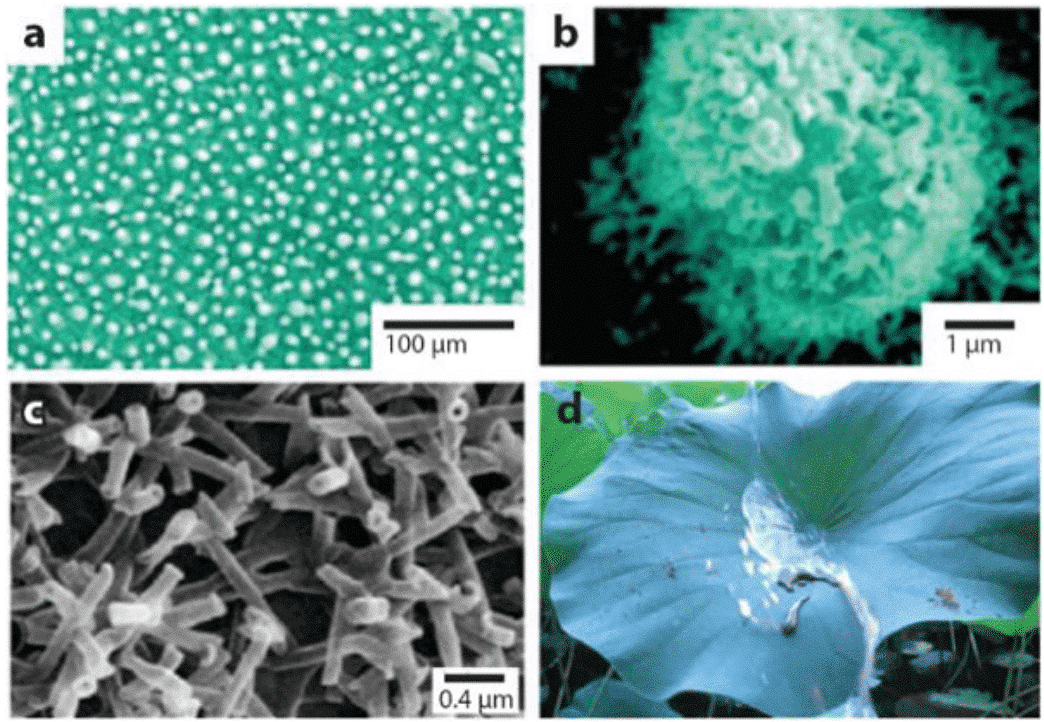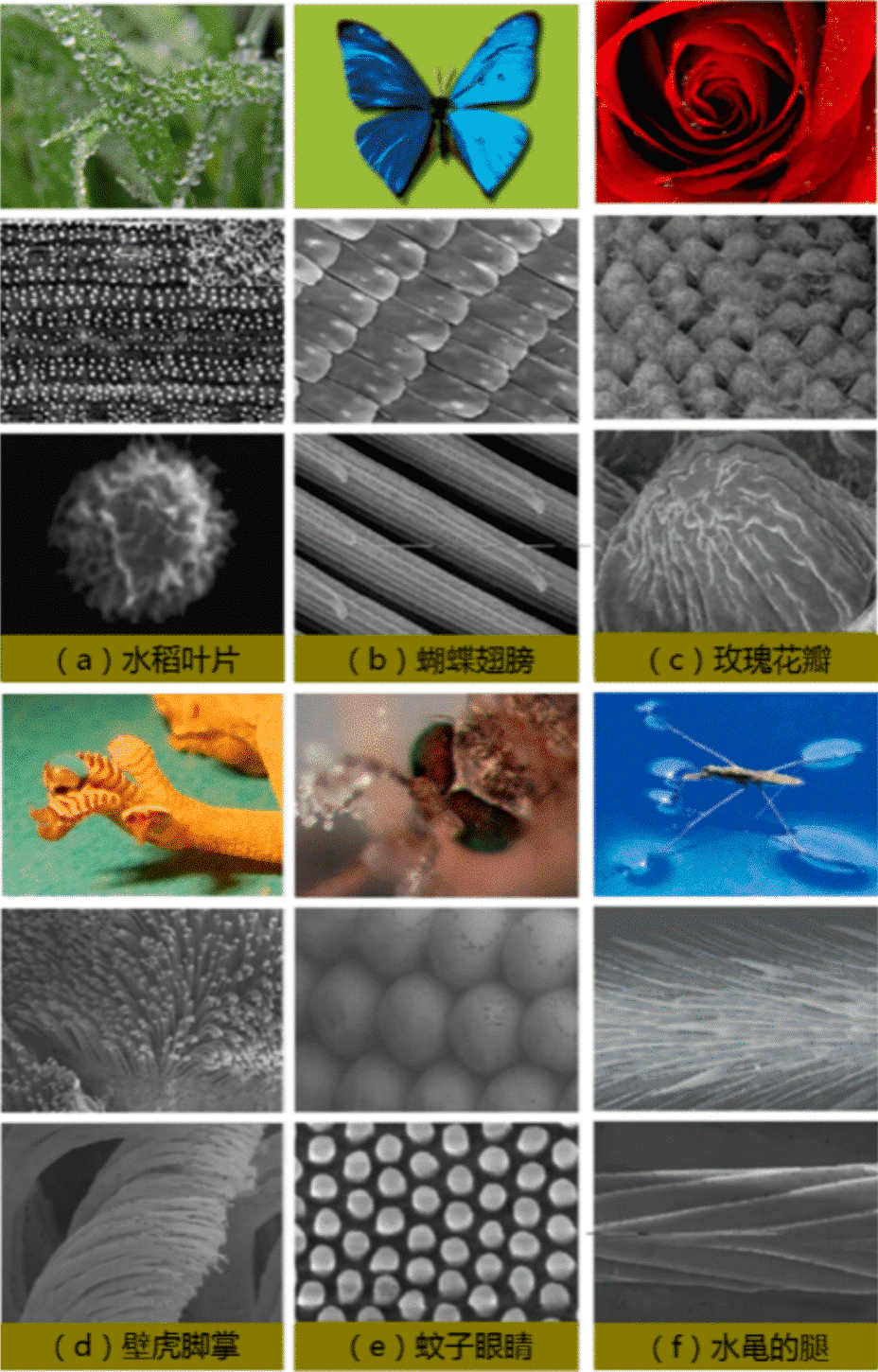O que é um material super-hidrofóbico?
O material superhidrofóbico é um material repulsivo à água e as gotículas de água não são espalhadas de maneira deslizante na superfície do mesmo para manter a forma esférica, conseguindo assim o efeito de rolar a autolimpante. A molhabilidade é uma das propriedades importantes da superfície de materiais sólidos. Os principais fatores que determinam as propriedades de umedecimento da superfície do material incluem a composição química da superfície do material e a geometria microscópica da superfície. Portanto, os cientistas têm uma superfície com um ângulo de contato estático na água maior que 150 ° e um ângulo de rolagem menor que 10 ° chamado superfície super-hidrofóbica. Os materiais superhidrofóbicos geralmente têm uma estrutura composta micro-nano e um produto químico de baixa energia superficial, que também é um pré-requisito para se tornar um material superhidrofóbico. Devido às suas excelentes características de autolimpante, separação óleo-água, resistência à corrosão, anti-gelo e anti-embaciamento, superfícies super-hidrofóbicas têm sido favorecidas por cientistas de materiais nos últimos anos, atraindo um grande número de cientistas para investir no pesquisa de materiais super-hidrofóbicos.
In fact, more than 2,000 years ago, people found that some plants grow in the sludge, but its leaves are almost always clean, a typical example is the lotus leaf. Lotus flowers usually grow in swamps and shallow waters, but they have the characteristics of “sludge and not dyeing”, which makes the lotus flower a symbol of purity for thousands of years. Dust and dirt on the lotus leaf can be easily carried away by dewdrops and rain, keeping the surface clean. Scientists call this sub-cleaning phenomenon “the lotus effect.”
However, the mechanism of the lotus leaf always kept clean has not been known until the development of scanning electron microscopy (SEM) in the mid-1960s, and people gradually unveiled the secret of the lotus leaf. In 1977, Barthlott and Neinhuis of the University of Berne, Germany, studied the surface structure of the lotus leaf by scanning electron microscopy (as shown in Figure 1). It is revealed that the micron mastoid structure on the surface of the lotus leaf and the wax substance are the key to its self-cleaning function. They believe that the resulting “leaf effect” is caused by a combination of a low surface energy material such as a waxy substance and a micron rough structure of the milky process.
Estudos demonstraram que um grande número de estruturas de microemulsão de cera do tamanho de um mícron é distribuído na superfície da folha de lótus (Fig. 1 (a)); um grande número de estruturas ramificadas finas em nanoescala é distribuído em cada mastóide (Fig. 1 (b)); Além disso, existem muitos tubos finos tridimensionais cerosos na epiderme da folha de lótus (Fig. 1 (c)). Essa estrutura compósita micro-nano resulta em uma baixa área de contato entre as gotas de água e a superfície da folha de lótus. Portanto, o componente de cera da superfície da folha de lótus e a estrutura micro / nano compósita trabalham juntos para proporcionar uma super-hidrofobicidade única e baixa adesão à folha de lótus. O ângulo de contato e o ângulo de rolagem da água na folha de lótus são de aproximadamente 160 ° e 2 °, respectivamente. As gotículas de água são quase esféricas na superfície da folha de lótus e podem rolar livremente em todas as direções, removendo o pó na superfície da folha de lótus, mostrando um bom efeito de autolimpeza (Fig. 1 (d)). O efeito de lótus, ou seja, a superfície autolimpante, exibe uma forte capacidade antipoluição quando o ângulo de contato com a água é superior a 150 °, ou seja, contaminantes da superfície como poeira podem ser levados pelas gotas de água que caem sem deixando vestígios.

Figura 1 Imagem SEM da superfície da folha de lótus
In addition to lotus leaves, there are many plants and animals in the world that are superhydrophobic. The water droplets on the leaves of the rice are more individual than the water droplets on the surface of the lotus leaf. Unlike the water droplets on the surface of the lotus leaf, which can roll in any direction, the water droplets on the leaves of the rice can easily roll in the direction of the blade growth, while it is more difficult to roll in the vertical direction. This is because the rice leaves have a line-oriented array of protrusions and a one-dimensional groove structure (Fig. 2(a)). In the direction horizontal to the growth of the blade, the rolling angle of the droplet is 3° – 5°, and in the vertical direction, the rolling angle is 9° – 15°. The linear alignment of the mastoid structure on the surface of the rice leaf provides the droplets with different energy barriers that infiltrate in both directions. Similar to the wings of a butterfly, when the butterfly wings are fanned, the water droplets will roll along the axis of the axis so that the droplets do not wet the body of the butterfly. It turns out that the butterfly wings are covered by a large number of micro-nano scales oriented along the axis of the axis (Fig. 2(b)). This highly directional micro-nano structure effectively affects the wetting behavior of water droplets, so that water droplets can easily roll away in the radial direction while being embedded in the opposite direction. Two different states can be adjusted by controlling the posture of the flapping of the wings or the direction of the air passing through the surface of the wings. This anisotropic adhesion allows the butterfly wings to be directionally cleaned in a humid environment, ensuring stability during flight and avoiding dust accumulation.
Unlike small water droplets on the surface of the lotus leaf that can be easily rolled, the small drops of water on the rose petals tend to adhere to the surface. Through microscopic exploration of rose petals, the scientists found that the surface of rose petals is composed of micron-sized mastoids, while at the tip of the mastoids, there are many nano-scale folded structures, and this nano-folding structure is the result of high adhesion of rose petals. The key factor (Figure 2 (c)). Gas can be present in the nano-folded structure, while water can easily penetrate between the micro-mammary. The same thing as the rose petals is the gecko’s sole. The gecko’s sole is super-hydrophobic and self-cleaning, but what excites scientists is that the gecko’s sole has an ultra-adhesive ability to move freely on a smooth surface. This is due to the well-aligned micronized bristles on the surface of the gecko’s sole, which are composed of hundreds of smaller nanoscale ends (Fig. 2(d)). The Van der Waals force generated by the contact between the nanotips of the gecko bristles and the solid surface is the support of the gecko to crawl at various angles.
The mosquito compound eyes are arranged with tight hexagonal small eyes, and a tight hexagonal protrusion is arranged on each small eye (Fig. 2(e)). This unique composite structure makes the compound eyes of mosquitoes extremely hydrophobic. When the mosquito is exposed to a misty environment, it can be found that very small droplets are not formed on the surface of the mosquito’s eye, and a large amount of droplets are condensed on the fluff around the mosquito’s eye. This extremely hydrophobic nature prevents the droplets from adhering and agglomerating on the surface of the mosquito’s eyes, giving the mosquito a clear view. This discovery provides an inspiring research idea for the development of dry anti-fog surface materials.
A lontra pode caminhar facilmente ou até pular na água. O segredo é a poderosa super-hidrofobicidade de suas pernas peludas. Quando a lontra fica na superfície da água, suas pernas formam um vórtice com uma profundidade de cerca de 4 mm, em vez de perfurar a superfície da água. Cada perna possui uma força super-hidrofóbica forte e durável, capaz de suportar cerca de 15 vezes o seu peso. Ao mesmo tempo, também foi encontrada a microestrutura especial da perna de sanguessuga, e um grande número de microestruturas em forma de faixa ordenada cobriu as pernas da sanguessuga, essas microestruturas foram orientadas em um ângulo de cerca de 20 ° e cada estrutura de micro-tira Consiste em uma nano-ranhura em espiral (Fig. 2 (f)). Essa estrutura micro-nano multi-escala em camadas captura efetivamente o gás entre a perna da sanguessuga e a superfície da água para formar um poderoso filme de gás. A capacidade robusta e super-hidrofóbica das pernas da lontra inspira o design de novos equipamentos aquáticos.

Fig. 2 Microestrutura diferente de diferentes animais
Natural Revelation: From the “Lotus Effect” of Self-cleaning Surfaces to the Construction of Superhydrophobic Surfaces
Direito humano, direito da terra, céu e direito, o direito do Tao é natural. Ao estudar as folhas de plantas com super-hidrofobicidade na natureza, pode-se saber que a preparação de superfícies super-hidrofóbicas requer duas condições: uma é que a superfície do material tenha uma energia superficial muito baixa; a outra é que a superfície do material sólido tem uma certa rugosidade e um mícron. E a estrutura dupla do nano.
Do ângulo de contato estático da superfície sólida, a chave para determinar a liofobicidade da superfície sólida está na composição química da superfície do material, e a rugosidade da superfície apenas aumenta esse efeito. Portanto, ao construir uma superfície sólida super-hidrofóbica, é geralmente construir uma superfície rugosa em uma superfície com baixa energia superficial ou modificar uma substância com baixa energia superficial em uma superfície rugosa. Primeiro, as pessoas começaram a estudar a preparação de materiais de baixa energia superficial e descobriram que os materiais sólidos com menor energia superficial são materiais contendo siloxano e flúor. Entre eles, os materiais contendo flúor são os mais excelentes, e sua energia superficial é cerca de 10 mN / m menor que a do siloxano, e o flúor é o menor raio atômico de todos os elementos, exceto o hidrogênio. Possui forte eletronegatividade, alta energia de ligação de fluorocarbono, baixa energia coesa e alta estabilidade térmica e estabilidade química. Possui as características de resistência ao calor, resistência às intempéries, resistência química e baixo índice de refração. Quando a superfície do material - os grupos CF3 são empilhados em uma ordem firmemente compactada de hexágonos, a superfície sólida apresenta a menor tensão superficial de 6,7 mJ / m 2. Portanto, a maioria dos materiais atualmente preparados com baixa energia superficial são principalmente materiais contendo flúor. Além disso, as pessoas começaram a tentar métodos diferentes para controlar a estrutura da superfície para preparar revestimentos super-hidrofóbicos. Atualmente, métodos de auto-montagem camada por camada, métodos de deposição física ou química de vapor, métodos de ataque químico, métodos de moldagem, métodos de pulverização eletrostática e métodos sol-gel são comumente usados.
Oportunidades e desafios para materiais super-hidrofóbicos: durabilidade e transparência
Embora os materiais super-hidrofóbicos possuam amplas perspectivas de aplicação na vida real, ainda existem muitas dificuldades em realizar a aplicação generalizada da super-hidrofobicidade na prática, e o maior desafio é a durabilidade e a transparência. O revestimento hidrofóbico tem baixa adesão ao substrato, e a estrutura rugosa também é muito frágil. Quando a superfície é sujeita a efeitos mecânicos, como impacto e atrito, é facilmente danificada e perde propriedades super-hidrofóbicas. Portanto, o desenvolvimento de um revestimento super-hidrofóbico com anti-fricção estável ou uma superfície super-hidrofóbica com função de auto-reparo tornou-se um problema urgente no campo de pesquisa de materiais super-hidrofóbicos. Em geral, para obter super-hidrofóbica, a superfície terá uma certa rugosidade e, quanto maior a rugosidade, maior o índice de refração e menor a transparência. Isso limita bastante a aplicação de materiais super-hidrofóbicos em dispositivos ópticos.
Conclusão
Da natureza à biônica, materiais super-hidrofóbicos começaram a partir da folha de lótus e foram desenvolvidos até hoje. Os cientistas nunca deixaram de explorar a natureza. Acredito que à medida que aprofundamos nossa exploração da natureza, nossa compreensão da natureza continua a se aprofundar, e o campo da super-hidrofobicidade certamente fará um progresso maior.







